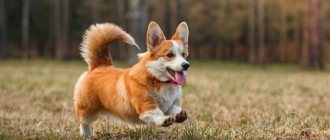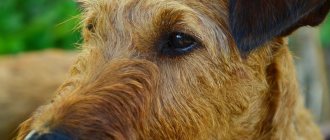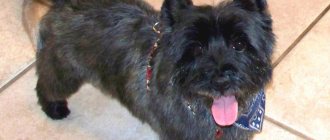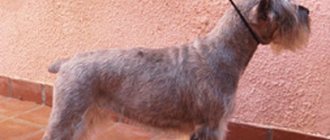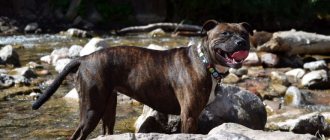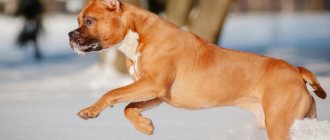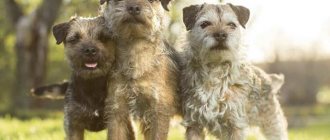Dental care is often overlooked when caring for dogs, but it is important to brush your pet's teeth at least two to three times a week to prevent plaque buildup. Brushing your teeth every day is ideal and can help prevent gum disease and bad dog breath.
Glen of Imaal Terriers are very smart dogs.
This makes learning relatively easy as long as you make it fun. Glens can become bored and distracted very easily, so it is important to keep training fun and interesting. You can start with some dog training basics, such as sit, stay, and come, and then move on to more advanced commands.
Glens are extremely energetic, athletic and playful, so daily exercise is a must. Aim for 30 minutes of activity, such as walking, running or playing catch, every day.
Remember: Glens get bored very easily, so keeping them engaged and getting some of their energy out is extremely important. Like other terriers, Glens love to dig and will happily work off some of their excess energy by digging holes throughout your yard.
Maintenance, care and nutrition of glens
Keeping the Irish Glen of Imaal Terrier does not have any difficult features. He easily tolerates the conditions of an apartment, but in a private house with free space for a party he will be better off than within four walls. The pet is in fairly good health and has very few diseases to which the terrier is predisposed. Among the usual rules for keeping Glens are:
- regular ear cleaning and removal of excess hair,
- periodic combing of fur,
- maintaining a cool air temperature in the hot season and trimming the coat to avoid overheating of the animal,
- long walks, preferably on a leash, although with a less active owner the terrier can feel quite good without proper activity,
- water procedures no more than once a quarter or in exceptional cases as urgently necessary.
The Irish dog is a lover of food, so you need to moderate his appetite in time and reduce the amount of food consumed, otherwise it will be quite difficult for short legs to hold a long body with excess weight. Due to excess weight, the terrier may develop problems with the heart and joints.
The Irish Imaal eats almost anything, so feeding him is a pleasure. Dog breeders advise giving him chunky meat rather than minced meat, since the latter is difficult to digest. Like other breeds, Glen's diet should include cereals, vegetable oils, vitamin-rich greens, offal, and fish.
How much does it cost and where can I buy it?
In UK kennels the average cost of a Glen of Imaal Terrier puppy is £1,200. In Europe it usually fluctuates around 800-1200 euros.
Buying a Glen of Imaal Terrier puppy close to home will most likely be problematic. There are no nurseries in Russia. There are individual representatives of the breed, which owners sometimes breed to sell puppies, but it is very rare to come across such advertisements. There are large nurseries in Finland and of course in Ireland. You can find information about breeders in Poland on the Internet, but it has not been updated for a long time.
Content
Thanks to its small size, the Toy Fox Terrier fits perfectly into a house or apartment of any size. But his noisy nature and high level of activity will not give anyone a break. Throughout the day, the dog will actively participate in all activities and ask to be played with. Amertoi are very thermophilic, even if they have their own cozy house, they will prefer to sleep on the master’s bed. Don't be surprised if you find a miracle inside a duvet cover; they love to cover themselves with their ears. Owners of toy fox terriers always need to be on guard; dogs are partial to litter.
Never cheerful, energetic, agile and athletic, the Toy Fox Terrier needs good physical exercise and regular walking.
Care
There is nothing complicated in caring for amertoi. It is recommended to brush your dog once a week. This will help get rid of mature hairs and have a massage effect. Fully bathe the dog as needed. In winter, she practically doesn’t get dirty, while in summer she loves to roll around in the ground; besides, it’s hot, and sometimes she has to bathe once a week. With this frequency, use only those shampoos that are intended for frequent washing.
Clean your ears once a week. Claws are trimmed every 3-4 weeks. Some dogs have problems with the anal glands, which are located on either side of the anus. They need to be cleaned as often as necessary.
And of course, don’t forget about your teeth. Good quality baby teeth are not required at shows; they will fall out anyway. Nevertheless, you need to take care of them and their oral cavity from puppyhood. The main thing is to regularly clean them with a special brush and toothpaste.
Clothes and accessories
Short fur without undercoat will not warm the dog in the cold season. Amerta needs comfortable clothes for the weather. It is better to accustom your dog to dressing from early childhood.
For walks, it is better to purchase a leash-roulette and a harness of the same size or a wide collar, as for Italian Greyhounds, which will not damage the trachea and choke the dog. You can let an Amertoya off the leash only if you are completely sure that he will not find any adventures on his tail, will not rush at other brothers, pick up things from the floor that cannot be eaten, or run away from the owner in search of something more interesting.
Most Toy Foxes prefer small squeaky toys and balls. Your dog's toys should not contain small parts that he can swallow. It is better to give preference to latex products; if swallowed, the bitten pieces do not damage the intestinal walls and come out naturally.
Nutrition
Breeders recommend feeding miniature dogs high-quality dry or wet food. Amertoi are rarely picky about food and, on the contrary, are often prone to overeating and gaining excess weight. A properly selected diet will allow the Fox to always remain active, healthy and cheerful. Most food manufacturers offer balanced diets for miniature breeds. The amount of food is calculated based on the dog’s weight. During the cold season, the portions can be slightly increased; this is also allowed if the dog is very active.
Best updates on the site
Pages: … 88 … 88
| 09.22.2010. Section: DOG BREEDS Bernese Mountain Dog KENNEL – Bernie Love Joy, Russia. Information about the nursery, photos... |
| 09.22.2010. Section: DOG BREEDS TOSA-INU PHOTOS – General photo album of the breed, page 6… |
| 09.22.2010. Section: DOG BREEDS GERMAN SHEPHERD DOG – Caesar Vom Bondarhaus. Detailed information about the dog, pedigree, photo... |
| 09.22.2010. Section: DOG BREEDS DAX PHOTOS – Wiserichard's Nursery, Russia. Personal photo gallery, page 30... |
| 09.21.2010. Section: DOG BREEDS DAX PHOTOS – Wiserichard's Nursery, Russia. Personal photo gallery, page 27... |
| 09.21.2010. Section: DOG BREEDS MOSCOW GUARD PHOTOS – General photo album of the breed, page 34… |
| 09.20.2010. Section: DOG BREEDS GERMAN SHEPHERD PHOTOS – Cezars Vom Bondarhaus, Latvia. Personal photo gallery of a dog, page 3… |
| 09/19/2010. Section: DOG BREEDS MITTELSHNAUZER NURSERY – Enigma Gris, Belarus. Information about the nursery, photos... |
| 09/19/2010. Section: DOG BREEDS GIANT SCHNAUZER PHOTOS – Lady Winter From Black Pearl, Ukraine. Personal photo gallery of a dog, page 2… |
| 09/19/2010. Section: DOG BREEDS MOSCOW GUARD PHOTOS – Lizzie Maggie Cash, Ukraine. Personal photo gallery of a dog, page 3… |
| 09/18/2010. Section: DOG BREEDS MOSCOW GUARD DOG – Weiss Iz Don-Grad, owner: Kovaleva, Ukraine. Offered for breeding. Detailed information about the dog, pedigree, photo... |
| 09/18/2010. Section: DOG BREEDS KURZHAAR PHOTOS – General photo album of the breed, page 10… |
| 09/17/2010. Section: DOG BREEDS PEKINGESE PHOTOS – General photo album of the breed, page 10… |
| 09.15.2010. Section: DOG BREEDS JACK RUSSELL TERRIER KENNEL – From the Stuart Dynasty, Russia. Information about the nursery, photos... |
| 09.14.2010. Section: DOG BREEDS SAMOYED DOG PHOTOS – General photo album of the breed, page 14… |
| 09/13/2010. Section: DOG BREEDS AMERICAN STAFFORDSHIRE TERRIER DOG – Enstein Kaiser For Ringstarstaff, owner: Safonova, Natalia Khotenova, Latvia. Detailed information about the dog, pedigree, photo... |
| 09/13/2010. Section: DOG BREEDS GERMAN SHEPHERD PHOTOS – Caro Vom Bondarhaus, Latvia. Personal photo gallery of a dog, page 3… |
| 09/13/2010. Section: DOG BREEDS RUSSIAN HOUND SIGHTHOUND NURSERY – Step' Kybanskaja, Russia. Information about the nursery, photos... |
| 09/13/2010. Section: DOG BREEDS DAX PHOTOS – Wiserichard's Nursery, Russia. Personal photo gallery, page 26… |
| 09/12/2010. Section: DOG BREEDS BULL TERRIER PHOTOS – Lola and other dogs. General photo album of the breed, page 11... |
| 09/12/2010. Section: DOG BREEDS YORKSHIRE TERRIER NURSERY – Valdrix, Latvia. Information about the nursery, photos... |
| 09/12/2010. Section: DOG BREEDS FRENCH BULLDOG PHOTOS – Nikolette-Lorin De Bon't, Latvia. Personal photo gallery of a dog, page 2… |
| 09/12/2010. Section: DOG BREEDS SIBERIAN HUSKY DOG – Klarissa, owner: Glamazda, Latvia. Offered for breeding. Detailed information about the dog, pedigree, photo... |
| 09/12/2010. Section: DOG BREEDS GERMAN SHEPHERD DOG – Caro Vom Bondarhaus, owner: Rosenbergs, Latvia. Offered for breeding. Detailed information about the dog, pedigree, photo... |
| 09/11/2010. Section: DOG BREEDS YORKSHIRE TERRIER DOG – Durbahler Club May-Ringen, owner: Tsybulskaya, Russia. Detailed information about the dog, pedigree, photo... |
| 09/10/2010. Section: DOG BREEDS DAX PHOTOS – Wiserichard's Nursery, Russia. Personal photo gallery, page 26… |
| 09/10/2010. Section: DOG BREEDS BICHON FRISE DOG – Frizzled Life Estee, owner: Sidko, Ukraine. Offered for breeding. Detailed information about the dog, pedigree, photo... |
| 09/10/2010. Section: DOG BREEDS GERMAN SHEPHERD DOG – Rex, owner: Adamovich, Ukraine. Detailed information about the dog, pedigree, photo... |
| 09.09.2010. Section: DOG BREEDS CHOW-CHOW DOG – Yashma Smolgiv, owner: Novitskaya, Belarus. Offered for breeding. Detailed information about the dog, pedigree, photo... |
| 09.09.2010. Section: DOG BREEDS RHODESIAN RIDGEBACK PHOTOS – Nursery “Dikaya Staya”, Moldova. Personal photo gallery… |
Character
The Irish Glen of Immal is an energetic, courageous, patient and loyal dog. Soft and gentle in the family, but energetic and persistent in the hunt. He is sensitive to his owner's tone of voice and will not obey if he feels he is stronger than his owner, however he also does not respond to harsh discipline. The owner must be calm, but have natural authority. If he feels that the owner is passive he will become stubborn, persistent, and dominant.
These dogs are loyal to other pets. Playful and good with children. The helen should not be left alone with small animals due to its hunting instincts. You need to be especially careful with animals such as hamsters, rabbits and mice. With the right human guidance, they can get along well with other dogs. They easily get along with cats if they came into the house earlier. House rules must be clear and binding. Training should always be supplemented with game elements.
Glens require their coats to be trimmed twice a year. The under tail should be cut with scissors as needed. Ear hair should be trimmed regularly and hair between the toes should also be removed. The Glens are eager to learn. They love to dig and chase. These dogs will bark if they detect danger, but rarely bark without a reason.
Relationships with people and animals
The Glen of Imal Terrier loves his people very much, and it is not recommended to leave him alone for a long time, nor should you deprive your pet of attention. If you live in a private sector, the Glen Imal Terrier will definitely defend its territory and react aggressively to any dog that appears within reach - behind the fence. The same will happen with strangers.
In addition, keep in mind that the Glen of England Terrier breed has strong hunting instincts, and will certainly chase cats and small animals, and will certainly dig a mole hole. In general, their instinct to dig is quite strong. So your flower beds, beds and perfect, trimmed lawn are at risk.
History of the Glen of Imaal Terrier
Originally from the desolate Wicklow Mountains of Ireland, Glen of Imaal Terriers were originally bred as working dogs. In addition to tracking foxes and badgers on hunts and keeping owners' homes pest-free, Glens were also used as turntable dogs, turning a turntable over a fire to cook food, and as working dogs on the rock farms behind the Wicklow Mountains.
Their short, powerful legs and muscular body made them ideal for farm work, and their tough nature allowed them to protect farms from rats, badgers and other vermin.
The Glen of Imaal Terrier was first shown at the Lisburn Dog Show in England in 1870. However, he was not recognized as a Glen of Imaal Terrier, since all terriers from Ireland were considered simply Irish terriers.
A few years later, after the Glens received their official name, they were adopted by the Irish Kennel Club in 1934. Then, after almost 70 years, they were officially recognized by the American Kennel Club in 2004.
Origin story
Glen of Imaal Terriers were bred in the mountains of southeast Ireland. They hunted foxes, badgers and rabbits. They were also used to control rodents.
People first started talking about this breed in 1870; these dogs took part in one of the exhibitions that took place in England. However, at that time the dogs of Ireland were not divided by name. They were just Irish terriers. Dogs called the Glen of Imaal Terrier were officially recognized by the Irish Kennel Club only in 1934. The breed received official recognition from the English Kennel Club in 1975. This breed is still considered quite rare to this day.
Description of the exterior of the Glen of Imaal Terrier
The appearance of the representative of the breed is quite unique. Dirty and disheveled after a hunt, he is no different from a shaggy mongrel, and when washed and combed, he gives the impression of a decorative dog. But this is only at first glance. All the strong stature and stocky build of the terrier leaves no doubt - this is a very strong, hardy and energetic dog, perfectly adapted to burrow hunting and capable of defeating a badger or fox on its own. This is a real fighter, not a lapdog.
The size of this terrier (according to the standard) is quite comparable to the size of the bulk of terriers. Height at the withers reaches an average of 35–36 centimeters with a body weight of up to 16 kg. Naturally, females are somewhat smaller.
- The Glen Terrier's head is somewhat elongated, with a rather wide skull. The stop is distinct and pronounced. The animal's muzzle is wide at the frontal part and gradually narrows towards the nose. The bridge of the nose is moderately wide and level. The nose is black. The lips fit tightly to the jaws (without the formation of jowls) and are black or grayish-black in color. The terrier has strong jaws and an excellent grip. The bite of large white teeth (full formula) resembles a scissors.
- According to the current standard, eyes should be small and not protruding (which allows them to be protected from injury during underground movements and in a fight with a badger), and can only be dark in color (light or yellow eye colors are not allowed). The terrier's gaze is very smart, lively and decisive.
- The ears are thick, small, triangular in shape, set high and funny - “...like a clam shell.”
- The neck is muscular, strong, and close to medium in length.
- The body is strong, elongated (in length it resembles a not too long dachshund), with a wide and deep chest, a straight strong back, a somewhat convex loin and a taut hemline.
- The tail is thick at the base and set high. In the best case, it should be very dense and strong, with the obligatory cheerful waving. The tail is abundantly covered with coarse hair, but should not form excessive fringe. The tail is docked in puppies at 3/4 of its original length.
- The Irish Terrier's limbs are of medium length, strong and muscular, straight (there may be some splay from the pasterns in the front limbs, but general clubfoot or wide-leggedness is not allowed). The paws are oval in shape, with dense pads and strong black claws.
- The wool is dense and rigid in structure (ideally it resembles the quality of wire), of medium length, without shaggyness or curliness. The length of the fur on the head is within 2-3 centimeters, and the so-called “beard” and “mustache” are more than 5 centimeters. There is a soft, dense undercoat.
- The coat color of the Glen Terrier has several varieties. The most common colors (approved by the standard) are: fawn (from light fawn to golden red), wheaten, gray brindle (but not too dark), reddish brindle. It is preferable when the dog has a more uniform, uniform color.
Hairless Terrier Health
There is no data yet on genetic diseases of the young breed. Terriers are long-lived. Their average lifespan can be up to fifteen children. The only weak point of the animal is the skin. Therefore, in the summer, you need to protect your dog’s skin from direct sunlight. And in the winter season it is recommended to wear more clothes.
In addition, terriers often suffer from the following diseases:
- Gastrointestinal tract, such as gastritis and enteritis.
- In addition, the dog may suffer from hepatitis, adenovirus or staphylococcus.
But as a rule, dogs have a strong immune system.
Features of caring for the Hairless American Terrier
There are certain rules that should be followed in order for the dog to live for many years.
First, skin care. This breed's skin needs to be wiped down from time to time.
Particular attention is paid to cosmetics for dogs. Since the terrier suffers from allergic rashes, the shampoo should be natural
It is recommended to bathe your pet several times a week. It is necessary to wipe the skin every day.
Secondly, you need to take care of your pet's teeth. Even though terriers have strong teeth and jaws, their gums can become inflamed. As soon as symptoms of inflammation are detected, it is recommended to immediately consult a doctor.
Thirdly, constant care of the ears and eyes is necessary. You need to wipe them down several times a week.
Fourthly, the dog should eat a dietary diet. Fried and stewed foods are not allowed. The diet should consist of lean meats. Terriers love dairy products, but it should be given in moderation. It is recommended to give dogs boiled eggs twice a week. But it is also recommended to feed dogs dry food.
Fifth, watch your claws. Nails need to be trimmed once every four months. In this case, there is no need to trim them completely. During a walk, the dog will wear off some of its nails. Overly active dogs do not need nail trimming.
Sixthly, the hairless terrier is an ideal dog as a first pet. He will please the owner and obey him. But before you train your dog, it is recommended to first raise him to be calm and affectionate.
Health
With proper care, Glen Terriers live 12 - 14 years. These dogs are hardy and can withstand any weather conditions well. The breed has a predisposition to some genetic pathologies, such as:
- Retinal atrophy.
- Cardiovascular diseases.
- Dysplasia of the hip and elbow joints.
- Hypothyroidism.
- von Willebrand's disease.
It is very important that your veterinarian examine your dog's eyes regularly, as retinal atrophy can lead to blindness. Your pet must be regularly vaccinated against infectious diseases of dogs.
Glen of Imaal Terrier is considered a rare breed of dog, the cost of a puppy varies from 500 to 1100 euros .
Features of maintenance and care
Dogs adapt well to different weather conditions, so they can be kept indoors or in an outdoor kennel. However, in hot weather it is necessary to provide your pet with a place where he can hide from the sun. Features of living in an apartment and a private house:
- If the dog lives in the city, it is necessary to walk it 2-3 times a day. During the walk, you should provide your pet with active rest, since the dog needs good physical activity.
- When living in a private house, you should take into account that glens love to dig holes and are able to get out of the yard by making a hole under the fence.
Caring for an animal's fur is easy. It does not tangle, but to maintain a neat appearance and reduce the amount of hair on carpets, you need to comb the wool several times a week. You need to bathe your dog as soon as it gets dirty. If possible, you should adhere to the frequency of bathing - once every 6 months. Features of care and nutrition are described in the table.
| Direction | Description | Periodicity |
| Claws | Shortening when they do not wear off naturally. | As it grows |
| Ears | Regular examination, trimming hair in the ears. | Once every 3–4 months |
| Eyes | Rubbing with chamomile solution. | In one day |
| Feeding | It is recommended to ensure that the dog does not overeat. The basis of nutrition is lean meat and offal. You can give rice, oatmeal, buckwheat every day. You need to mix vegetables and finely chopped herbs into your dishes. Once a week, dogs are fed lean fish and given 1 boiled egg. Fermented milk products are added to the diet several times a week. It is forbidden to give your pet sweets, flour and pasta, legumes, fatty and spicy foods, garlic and onions. | An adult dog is fed 2 times a day. |
Description of the breed
The first representatives of the breed were fighting dogs and achieved official recognition at the beginning of the last century. Despite the hunting qualities, which include some aggressiveness of the animal, when living together with a person, Irish terriers behave balancedly and become his helpers and companions.
The external image of a terrier is very different if you look at the dog during and after a hunt. In the first case, it is a shaggy, not too neat-looking animal, not much different from an ordinary yard dog. But the appearance of the Irishman changes greatly when he participates in shows and exhibitions. The terrier appears in a different guise - clean, combed, looking like a decorative dog.
Certain requirements for the appearance of the animal have been developed for the breed.
- The terrier has a slightly elongated but wide head, the muzzle tapers from the forehead to the nose with a black nose. The lips are also black or gray-black, optimally adjacent to the jaw. The bite is correct, scissor-shaped.
- The ears are triangular in shape, small but thick, set high.
- The eyes are small, non-protruding, dark in color, with a lively, fearless and attentive gaze.
- The medium-sized neck is distinguished by its strength and strong muscles.
- The terrier's body is elongated in shape, with a deep and wide sternum. The back is flat and straight, the lower back stands out in relief, the stomach is tucked.
- The tail is set high, thick at the base, and covered with coarse hair. It is customary to crop this part of the body by one third.
- The dog's legs are straight, strong, of moderate length with oval paws and black claws; a slight inversion of the front paws is allowed.
According to the standard, the dog should not have jowls, light or amber shades of eyes, excessively hanging tail fringe, or club feet.
The undercoat is thick and soft. The color of the Glen of Imaala in accordance with the standards can be as follows:
- gray brindle (blue);
- reddish brindle;
- fawn (light and expressed with golden and red hues).
The dog may have a dark gray stripe on the back and a mask, but patches of white on the chest and legs are undesirable. The height of males at the withers is 35-36 cm, weight is no more than 16 kg. Accordingly, girls are smaller in height and body weight.
Exterior
Glen Terriers are dogs of medium height and fairly massive build. The height at the withers for males is 30-35 cm , for females 29-34.5 cm , weight respectively 13-16.5 kg , 12.5-15.5 kg . The dog's head is quite large with a pronounced transition from the forehead to the muzzle. The eyes are round, dark brown in color, covered with thick eyebrows to protect them from blockages while working in the burrow. The nose is large and black. The ears are small, hang down, and when alert, the dog raises them up.
The neck is muscular and strong, of medium length. The dog's back is straight, the lower back is strong, and the belly is neatly tucked. The front and rear limbs are even, parallel to each other, the paws are compact with fingers gathered into a ball and strong claws, the front paws are slightly turned to the sides. The tail is docked by 2/3 in childhood.
The dog's coat is of medium length (up to 8-10cm), hard, with a soft undercoat. The color can be wheaten, brindle, blue and red, fawn with various shades of red.
Conditions of detention
Terriers of this breed can be kept in an apartment, but since the dog likes to move a lot, a country house is more suitable for it, where there is more space for active games and activities. Caring for an animal involves fulfilling certain requirements. Protein must be present in the dog's diet, however, lean meat should be harmoniously combined with vegetables and grains. In addition, you will have to calculate calories so that the animal does not overeat.
Minced meat is undesirable on the menu, as it is poorly digested by the terrier’s body. He also needs greens for health, occasionally deboned fish, and a little vegetable oil for the normal condition of his skin and coat.
Terrier care consists of:
- on long walks;
- bathing once every 3 months or as the coat gets dirty;
- in regular removal of growing hair on the ears, in their cleaning.
The wool will need to be combed periodically (1-2 times every 7 days) to prevent tangles from forming.
Grooming is important in the warm season, and to make the animal feel comfortable, you can purchase a cooling mat for your pet and maintain a cool air temperature in the room.
Nutrition
Glen Terriers love to eat, so it is important to ensure that the dog does not overeat, as these dogs are prone to obesity. The dog’s diet must be balanced; the dog can eat both high-quality dry food and natural products
If the diet consists of natural products, then the terrier should eat the following foods:
- Lean meats.
- Offal.
- Porridge (oatmeal, wheat and rice).
- Boiled fish.
- Dairy products.
- Eggs.
- Vegetables and fruits, greens.
Vegetables can be given either raw or stewed with the addition of fish oil or flaxseed oil. Clean water must be available at all times.
Interesting Facts
It is very interesting, but the use of Glen of Imaal Terriers in ancient Ireland was not limited to hunting and exterminating rodents. The Irish were much more inventive. Glen Terriers, being very energetic and hardy dogs, as well as having compact sizes, were used in the old days as so-called “trochanter dogs”.
The main task of such a dog (or more often two, used in shifts) was to rotate the wheel. The terrier was placed inside a special wheel and rotated it during its run (based on the principle of a squirrel wheel). Various mechanisms were connected to the wheel using belts or gears. The most common were spinning wheels, bellows for pumping air, as well as devices for rotating a spit with meat for uniform frying (hence the name “spit dog”). The Irish probably preferred lamb well done. And this was a serious and not so simple task for the cook of those years.

